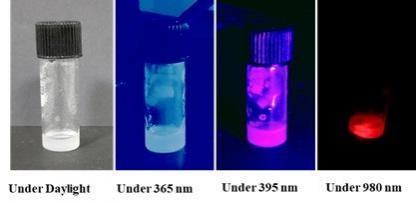
Scientists at the Institute of Nano Science and Technology (INST) have created a novel ink designed to combat counterfeiting. This innovative ink is aimed at preventing the duplication of currency, certificates, branded goods, and medicines. The development comes at a time when counterfeiting is on the rise globally, posing a significant threat to economies and businesses.
The team of scientists focused on rare earth ions with luminescent properties, known for their characteristic emissions of bismuth, a chemical element. Utilizing these properties, they synthesized a first-of-its-kind security ink based on luminescent nanomaterials with rare earth doping. This ink exhibits excitation-dependent luminescence, meaning it gives visible emission under both ultraviolet and near-infrared light.
The new ink offers enhanced security features through its ability to display different colors under various light wavelengths. Specifically, the ink appears vibrant blue under 365 nm light, pink under 395 nm light, and orange-red under 980 nm near-infrared (NIR) light. It remains effective under a range of light, temperature, and humidity conditions, making it a robust solution for security purposes.
The scientists used a simple co-precipitation method to synthesize the luminescent nanomaterial at 120 degrees Celsius. The nanomaterials were then dispersed into commercially available PVC ink. The mixture was used to create patterns and letters through a screen-printing technique. When the printed patterns are exposed to different wavelengths of light, they show the desired color changes, proving the effectiveness of the ink.

The team also enhanced the encryption and decryption capabilities of the ink by combining rare earth ions with well-known luminescent properties and bismuth with characteristic emissions. This improved its security potential, making it a powerful tool against counterfeiting.
The luminescent ink made from these nanomaterials can also be applied to fake-proof various items, including currency, certificates, medicines, and branded products. This allows both consumers and manufacturers to easily verify the authenticity of their items, providing a simple yet powerful tool to detect counterfeits.
In addition to its security applications, the ink also has potential uses in other areas. For example, it could be used in the production of high-contrast bioimaging nanoprobes, which are used in medical imaging to visualize biological processes at the cellular and molecular level. The ink's luminescent properties could enhance the contrast and clarity of these images, potentially improving diagnostic accuracy.
The development of this ink also has implications for the recovery of rare-earth metals. These metals are critical to the high-tech society we live in, being an essential component of mobile phones, computers, and many other everyday devices. However, increasing demand and limited global supply mean we must urgently find a way to recover these metals efficiently from discarded products. The use of environmentally friendly chemicals to recover rare-earth metals, as demonstrated in the production of this ink, could be a step in the right direction.















